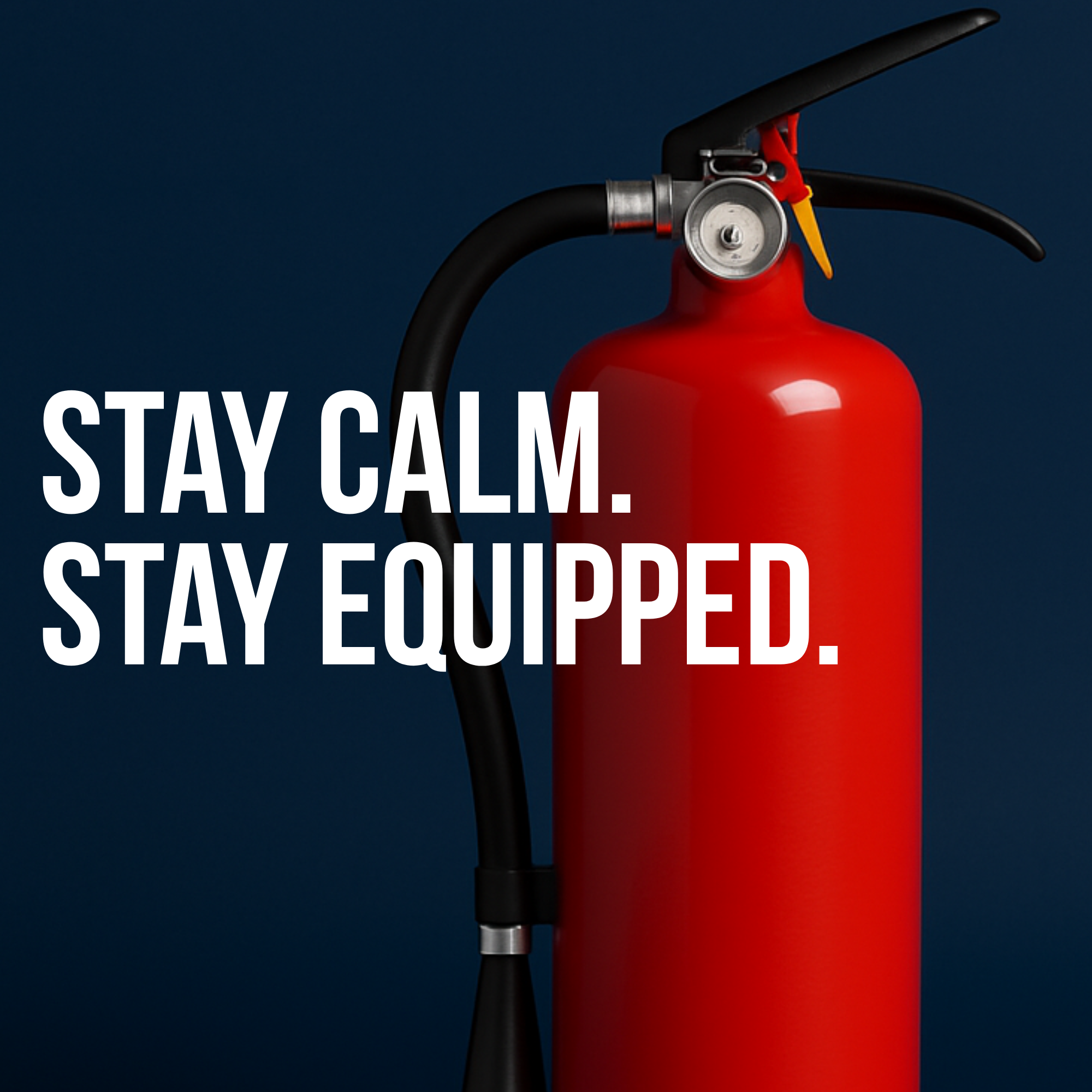- (800) 252-0368
- Monday - Friday: 8:00am to 5:00pm
- |
Fire Extinguishers 101: Choosing the Right Extinguisher for Your Home or Business - Prudential Alarm
- Home
- Fire & Life
- Fire Extinguishers 101: Choosing the Right Extinguisher for Your Home or Business

Every second counts in a fire emergency.
While a monitored fire alarm system is crucial for alerting authorities, a working fire extinguisher can be the difference between a small flare-up and a devastating structure fire.
But not all fires, or extinguishers, are the same. For homeowners and facility managers in Michigan and Ohio, understanding the fire classifications and selecting the right equipment is key to effective fire suppression.
The Five Fire Classes: Know Your Fuel
Fire extinguishers are categorized by the class of fire they are designed to suppress. Using the wrong type of extinguisher can make a fire worse or put the user in danger.
| Class | Type of Fuel | Example (Where You Find It) |
|---|---|---|
| A | Ordinary Combustibles | Wood, paper, cloth, trash (common household and office fires). |
| B | Flammable Liquids | Gasoline, oil, grease, paint, solvents, propane (kitchens, garages, workshops). |
| C | Electrical Equipment | Wiring, appliances, circuit breakers, motors (any equipment plugged in or electrified). |
| D | Combustible Metals | Magnesium, titanium, potassium (rarely found outside of specialized commercial or industrial settings). |
| K | Cooking Oils | Vegetable oils, animal fats (commercial kitchens with deep fryers). |
Understanding the ABCs: The History of Standardization
You see the letters A, B, and C on most extinguishers, but how did that system come to be?
The classification system was developed by organizations like the National Fire Protection Association (NFPA) and refined by Underwriters Laboratories (UL) in the 20th century to standardize safety. Before this, you might have had an extinguisher that was great for a chemical fire but deadly if used on an electrical one.
The classification is based on the extinguishing agent needed:
A (Ash): These fires leave ash behind. They are fought by cooling, usually with water or a chemical that melts and smothers the fire.
B (Boil/Barrel): These involve liquids that boil/vaporize. They must be fought by displacing oxygen and interrupting the chemical reaction, which is why water is useless.
C (Current): This class simply denotes that the fire involves an energized electrical source. The extinguisher agent must be non-conductive to protect the person using it, which is the sole focus of the ‘C’ rating.
The development of the ABC dry chemical (Monoammonium Phosphate) in the 1950s was revolutionary because it was the first agent that could safely and effectively tackle all three common types of fires, making it the versatile, multi-purpose unit we rely on today.
Choosing the Right Extinguisher Type (The ABCs of Protection)
For most homes and businesses, you’ll be looking for multi-purpose extinguishers that cover the most common fire types. Look for the corresponding letters printed on the side of the unit.
1. For the Residential Home (The Kitchen & Garage)
The vast majority of home fires involve Class A, B, or C materials.
Best Choice: ABC (Dry Chemical)
What it is: The most common extinguisher. It uses a fine powder (monoammonium phosphate) that effectively smothers Class A, B, and C fires.
Where to put it: Place one in your kitchen, one in your garage or workshop, and one on each floor of the home.
2. For the Office, Retail, or Warehouse (Commercial Class A/C)
Commercial spaces need robust coverage that protects both materials and electronics.
Best Choice: ABC or BC (Dry Chemical)
Class A/B/C units are the standard for general coverage near exits and in common areas.
For areas with sensitive electronic equipment (server rooms, control panels), Carbon Dioxide (CO2) extinguishers are preferred. They are effective on Class B and C fires and leave no residue, preventing damage to expensive hardware.
3. For Restaurants and Industrial Kitchens (The K-Class Requirement)
If your business involves large cooking appliances or deep fryers, a specialized extinguisher is legally required.
Best Choice: K-Class (Wet Chemical)
What it is: These use a potassium acetate solution to create a chemical reaction that suppresses the fire and cools the hot oils, preventing re-ignition.
Location: Must be easily accessible near deep fat fryers and cooking stations.
Extinguisher Maintenance: Readiness is Everything
An improperly maintained extinguisher is useless in an emergency. Follow these three steps to ensure your unit is ready:
Check the Gauge: The needle must be in the green zone. If it’s in the red, the extinguisher has lost pressure and needs immediate recharging or replacement.
Conduct a Visual Inspection: Look for a broken or missing safety pin, visible dents, corrosion, or a cracked hose. Ensure the nozzle is clear of any debris.
Perform Routine Shaking: Dry chemical (ABC) extinguishers can sometimes settle and compact the powder. Turn the unit upside down once a month and shake it vigorously to keep the contents loose and ready for discharge.Sample Text
The Final Layer of Protection
A fire extinguisher is an indispensable tool for fighting small, contained fires. However, it can never replace a professional fire detection and monitoring system.
For homes and businesses in Michigan and Ohio, an integrated system ensures that while you are taking immediate action, our 24/7 monitoring center is already alerting your local fire department.
Ready to secure your home or business with both reliable extinguishers and state-of-the-art alarms? Contact Prudential Alarm for a complete fire safety consultation.
Visit prudentialalarms.com/contact-us or call us at (800) 252-0368.

